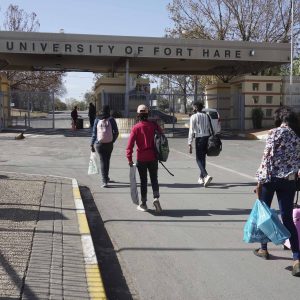Simplicity is key if SA is to harness technology
The so-called fourth industrial revolution is seen as a part solution to South Africa’s sluggish economy. But policy paralysis and a lack of stakeholder cooperation is crippling progress.
Author:
15 September 2020

The government, labour, business and societal organisations have identified the economic promise of the so-called fourth industrial revolution (4IR) as a focus area to rescue South Africa from its economic paralysis.
The plans and proposals presented at a recent session of the National Economic Development and Labour Council (Nedlac) – on what these four constituencies say will help set the country on the path of prosperity – are peppered with references to digitisation and how to build a green economy, free up spectrum and increase access to broadband.
But compared with global competition, South Africa is almost a backwater when it comes to developing coherent and comprehensive policy on 4IR.
A government document on the country’s economic recovery now and post Covid-19, presented at the Nedlac session in August, speaks volumes.
Related article:
“Digitisation is accelerating globally. Countries and populations that are not keeping up will be left even further behind. In SA this will lead to deeper inequalities. The process of ensuring universal access to affordable broadband and digital public services has become even more critically important and should be prioritised,” says the document.
It also mentions greening the economy to guarantee the security of energy, food and water, and supporting tourism by developing a “market access tool for distribution, [and] link with green economy”. But the country has yet to pass the Climate Change Bill that was written in 2018.
Wi-Fi for all
A document from industry group Business for South Africa, titled Post Covid-19: A New Inclusive Economic Future for South Africa, identifies digital economy acceleration as an opportunity before and after the coronavirus pandemic. It says digital migration and spectrum allocation are key to ensuring inclusive economic growth, job creation and a culture of delivery.
Digital migration is the process of moving broadcasters such as SABC and eTV, who use analogue signals to broadcast, away from this to satellite-based digital signals. This frees more data-carrying capacity in those analogue bands, which can be used for third, fourth and later even fifth generation (3G, 4G, 5G) mobile broadband services.
A joint proposal from labour federations the Congress of South African Trade Unions, the Federation of Unions of South Africa and the National Council of Trade Unions also mentions the digital economy under the headline “Reprioritised Jobs Summit Agreement”. They say rolling out the digital economy must be a key focal area to ensure that “workers can work, and learners and students can work from home”.
Related article:
“This must deal with the neverending digital spectrum delays, making data affordable [and] providing workers, learners and students with the necessary tools, eg, laptops, data, training, etc,” the document says.
The community constituency, which covers societal organisations, says the post Covid-19 jobs agenda must include “education, skills development, water, energy, ICT/broadband” as these are critical enablers for investment, growth and employment.
It calls for new forms of work to be fast-tracked and integrated into labour market reskilling and upskilling, accompanied by free Wi-Fi access across the country, including in townships and rural areas.
While the proposals from the Nedlac constituencies point in the right direction, the elephant in the room is the old South African challenge: consensus around what is wrong doesn’t translate into consensus about what should be done, let alone actually doing it. There is still no policy to lead the country to the promised land of 4IR.
Instead, it is clear that government departments continue to work in silos and that there is little collaboration between the public and private sectors.
Holographic president
After last year’s general election in May, the Department of Communication and the Department of Telecommunications and Postal Services merged to form the Department of Communications and Digital Technologies under the stewardship of the often controversial Stella Ndabeni-Abrahams.
Related article:
The country hosted its first Digital Economy Summit in July 2019, which promised to kick-start the process of collaborative and coherent policy-making on the digital economy. The summit was a success and even showcased some of the digital economy innovations under discussion. President Cyril Ramaphosa became the first head of state to speak at two venues at the same time, through the use of holographic technology that projected him in real time from Midrand to the Rustenburg Civic Centre in North West province.
This year, the presidential commission on 4IR that Ndabeni-Abrahams appointed last year released its report on recommendations and the way forward to the country’s digital economy future. The report says the commission, which comprises academic leaders in the sector and the government, focused on the role of the state and plans to “position outputs with stakeholders with a view to generate strategic pathways that will enable ownership and implementation of the strategy across society”.
Policy paralysis dilemma
But anyone hoping for a pot of gold at the end of the digital rainbow will be sorely disappointed. The report starts off with a basic history of industrial revolutions and ends with a suggestion that a “strategic pathways committee” be established. This should include the state’s basic and higher education departments, trade and industry, the Sector Education and Training Authority, universities, the South African College Principals Organisation, Universities South Africa, community colleges and industry.
Curiously, and this is the South African policy paralysis dilemma playing out again, the commission in effect proposes a committee to do what the commission itself should be doing.
It recommends establishing an artificial intelligence institute and a “platform for advanced manufacturing and new materials”, and proposes securing and making data available to enable innovation.
But the coronavirus onslaught has in many ways propelled the country forward. South Africa has suddenly had to be ready for that which it was busy discussing. And the picture is dismal.
Related article:
Most school pupils and students have lost five months of education because of the Covid-19 lockdown. Even those from well-to-do backgrounds have struggled with online learning, never mind the majority of the country’s future workforce whose reality is no access to internet data or laptops. On the other end of the spectrum are workers who are not only losing their jobs because of the pandemic but also do not have the skills to function in or harness the opportunities of the digital economy.
The waters are muddied further by the decade-long debacle over high-demand spectrum, the key “natural” resource we all need for the information age.
Spectrum sabotage
The Independent Communications Authority of South Africa has now announced that it has pushed back the process of licensing new spectrum by three months. Its preparations were overtaken by the need to release emergency spectrum with the work-from-home demands of the pandemic. A sensible enough explanation, until you consider that the need for new spectrum to power the digital economy was first identified in 2006, the year the state created Broadband Infraco to run the national “backbone network”.
Since then, policy dithering, political and commercial infighting, chronic instability in the government’s communication portfolio and the super profitability of the country’s two main mobile service providers – MTN and Vodacom – have sabotaged the process.
The process to migrate broadcast services away from analogue to digital should also free valuable spectrum in the prized sub-1 GigaHertz bands, but broadcast digital migration has been delayed for over a decade and the country has missed every self-imposed or international deadline to turn off analogue signals.
Related article:
Nothing better illustrates the mismanagement of the process, and the resulting policy uncertainty, than that 11 communications ministers have presided over it since 2009.
So, what is to be done?
There are many avenues to follow when embracing 4IR, but South Africa could consider taking a leaf out of Rwanda’s book. To kick-start its digital economy, Rwanda looked for a niche in the market and pursued it doggedly. That niche was drone technology.
Last year, Rwanda ICT and Innovation Minister Paula Ingabire spoke at the World Economic Forum on Africa summit about how the government had made a concerted effort to draft and implement regulations speedily on the use of drones. This was largely because of the willingness of different stakeholders to understand the risks without neglecting potential technology advances and its advantages.
The “need” for drones in Rwanda was simple: how to get blood and other medical necessities to isolated rural communities. By adopting and adapting a new 4IR technology to meet this need, Rwanda has created a tech ecosystem that is now reaching out into the broader economy.
Not only has healthcare improved but the knock-on effects have been huge. These include start-ups mushrooming, some of which use drones to spray pesticides in Rwanda’s marshlands to help combat malaria, and talking to other African countries such as Ghana and Tanzania about how they can adopt and benefit from Rwanda’s drone programmes.
South Africa has advantages that Rwanda – or even Ghana and Tanzania – can only dream of. But it seems to lack what these countries have in abundance, a simplicity of policy and process management.





